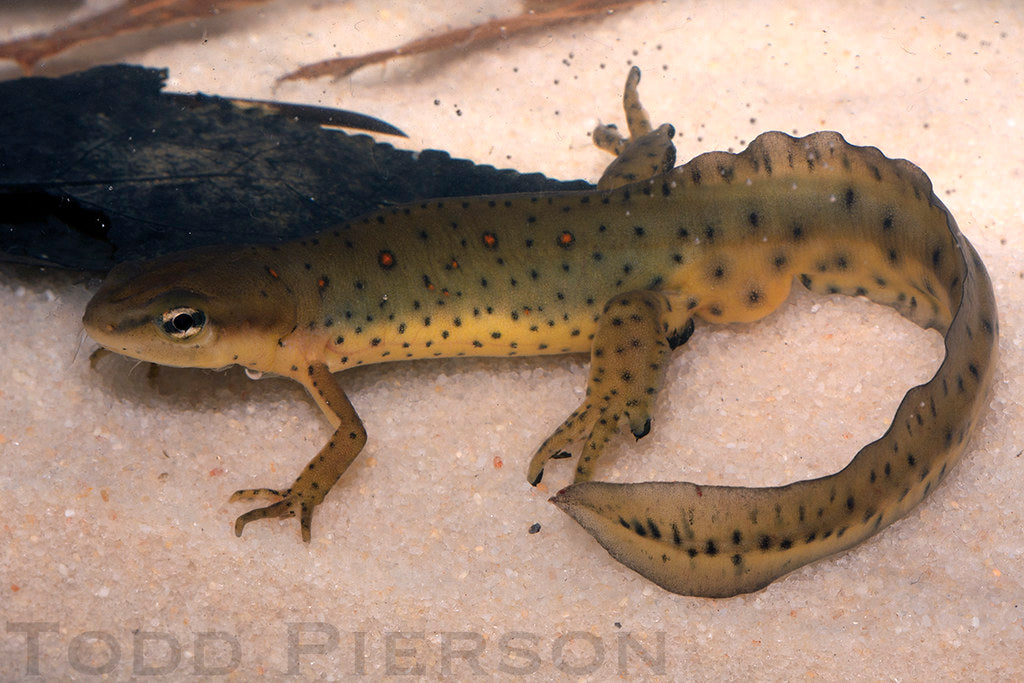The axolotl (Ambystoma mexicanum) is a large, fully-aquatic species of amphibian. They are exclusively native to Lake Xochimilco and Lake Chalco in Mexico. Although fairly common in captivity, this species is actually endangered in the wild.
Axolotls are typically 10-12” long, with smooth skin, a wide mouth, a dorsally flattened tail, and long, feathery gills. Coloring is usually mottled tan/green and brown, although other colors and patterns have become available through captive breeding. Axolotls are unique among amphibians because they never metamorphose, living their entire lives underwater and breathing with gills.
Axolotls are fairly easy to care for, making them beginner-level amphibians, although as a pet they’re more comparable to keeping fish than keeping a salamander. With good care, they generally live 10-15+ years.
How much space do axolotls need?
Axolotls are fully aquatic, so they need an enclosure that can hold plenty of water without leaking. The minimum size for one axolotl is 30”L x 12”W x 12”H, but larger is preferred. There should be a tightly-fitting lid on top to prevent potential escape via leaping.
Cohabitation (keeping multiple axolotls in one enclosure) is optional with a particularly large enclosure, but they are solitary animals and don’t require “friends” or “roommates.”
Do axolotls need UVB?
No, axolotls don’t need UVB lighting, as they are native to muddy waters where UVB wavelengths are essentially unable to penetrate.
However, ~6500K LED or fluorescent plant lighting is beneficial for growing live plants and highlighting the attractiveness of the aquarium. Lights should be on for 13 hours/day during summer and 11 hours/day during winter to simulate seasonal cycles and encourage healthier hormonal rhythms.
What temperatures do axolotls need?
Axolotls are ectotherms, which means that they rely on the temperature of their environment to help regulate their metabolism and stay healthy. Like fish, the water temperature should be maintained within a certain range. Optimal water temperature for axolotls is between 60-66°F.
If you’re keeping your axolotl in a basement or you normally keep your home at cooler temperatures, then this should happen naturally without need for additional equipment. However, if your home tends to be warmer, then you will need help keeping the water cool enough to keep your axolotl comfortable. You can either decrease the temperature of the entire room with an air conditioner, or you can decrease the temperature of just the water with an aquarium chiller.
Keep track of water temperatures with an aquarium thermometer.
What kind of water maintenance do axolotls need?
It’s important to keep the water in your axolotl’s aquarium clean in order to keep your pet healthy. Use a low flow aquarium filter designed for fish that prefer stagnant water — strong water flow will stress your axolotl out! To further reduce the likelihood of having a current in your aquarium, interrupt the filter's outflow with strategically-placed décor.
Perform partial water changes (20-30%) once per week. Any water added to the aquarium should be treated with dechlorinator like Zoo Med Reptisafe to prevent harmful chemicals from being introduced to your pet’s habitat, as amphibians are very sensitive to the chemicals in their environment. Use water test kits to make sure your water pH stays between 6.5-8.0, preferably 7.4-7.6.
Algae buildup should be manually scrubbed off with a brush or magnetic glass scrubber.
What substrate is good for axolotls?
Axolotls don’t require substrate, but it’s a good idea to add some to the aquarium to improve the enclosure’s appearance and, more importantly, give your axolotl some “grip” on the bottom of the tank, which some claim decreases stress.
Due to the fact that axolotls have a propensity for ingesting aquarium gravel, it’s best to use a substrate that is either too large for them to ingest or too small to cause a problem. The best substrate for axolotls is fine sand such as Exo Terra Riverbed Sand. This substrate must be routinely cleaned with a siphon to maintain good hygiene.
What décor can you use in an axolotl aquarium?
It’s terribly boring (and even stressful) for an axolotl to be stuck in an enclosure with nothing in it except water and substrate. It doesn’t matter how big the enclosure is if you don’t put things in it for your pet to use and interact with!
Décor options for axolotls include:
- mopani wood
- large stones
- live or artificial plants
- pre-made hides/caves
- artificial ornaments
Whatever you choose to use, make sure that your pet has cover to hide in so it can feel secure in its environment.
What do axolotls eat?
Axolotls are primarily carnivores, which means that they need to eat whole animal prey in order to get the nutrition that they need. Feed juveniles daily, and adults 2-3x/week. Offer as much food as they will eat within ~10 minutes, and clean up any excess at the end.
Food options for axolotls:
- Blackworms
- Bloodworms
- Brine shrimp
- Earthworms (chopped)
- Fish
- Tubifex worms
- Salamander pellets
- Salmon pellets
Certain commercial diets such as Omega One Newt & Salamander Pellets and Hikari Sinking Carnivore Pellets are a good idea to include in your axolotl’s diet because they will help ensure that your pet is getting enough vitamins and minerals.
Can axolotls be handled?
Very few amphibians actually “like” to be held, and given that axolotls are aquatic, it’s best to treat axolotls like fish and keep your hands off this pet.
*This care sheet contains only very basic information. Although it’s a good introduction, please do further research with high-quality sources to obtain additional information on caring for this species.



Leave a comment
This site is protected by hCaptcha and the hCaptcha Privacy Policy and Terms of Service apply.